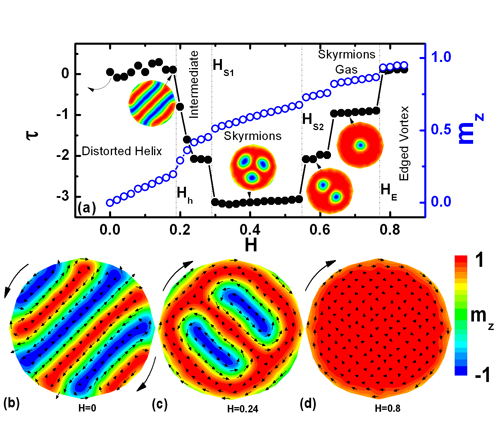Mar 21,2013|By
However, in bulk materials skyrmions survive only in a very narrow temperature-field (T-H) window. By contrary, the stabilized skyrmions may be realized by reducing the dimension of materials from bulk to two dimensional (2D). These results naturally lead to a question whether the stabilization of skymions can be further enhanced by continuingly reducing the sample size from a 2D film to nano-elements, such as nano-disk, ring, or stripe. It was known that the magnetic vortex is the stable ground state in micro-sized soft magnetic disk in order to reduce the magnetostatic energy. In analogous to the soft magnetic vortex, skymions are anticipated to be more stabilized in high symmetry nanostructured magnetic objects due to the magnetostatic couplings, such as nanodisk. Meanwhile, a number of very interesting and potentially useful memoryand logicdevices have been recently proposed through the formation and controlled manipulations of the spin textures in magnetic nano-elements. Unfortunately, the study of skyrmions at nano-scale is lacking and their magnetic properties still remain unclear.
In the present work, we calculate the equilibrium magnetization process of the helimagnets with uniaxial anisotropy and dipolar coupling in thin nanodisk by means of Monte Carlo simulation. The simulated results showed that the complex spin texture may be simply regarded as the superposition of edge state with their orientation of in plane spin perpendicular or parallel to the edge and bulk state with the features analogous to 2D chiral magnetic films. With the increase of the external magnetic field, the number of the parallel spins of the edge state increases, and finally the spin texture transfers into edged magnetic vortex. For bulk states, the field-driven spin textures proceed, in turn, from the helix state to countable skyrmions and the final ferromagnetic state. The arrangement of the skyrmions strongly depends on the disk size. In addition, for certain uniaxial anisotropy and dipolar coupling ranges, a special magnetic vortex with skyrmionic core is spontaneously formed even without the help of thermal fluctuation or external field when the disk size is comparable with the wavelength of helix state.

The typical ?eld-driven evolution of the chiral modulations for the disk with radius R=10
Ralative links:
Field-driven evolution of chiral spin textures in a thin helimagnet nanodisk
(http://prb.aps.org/abstract/PRB/v87/i1/e014401)
Contact:
Dr. TIAN Mingliang
High Magnetic Field Laboratory, Chinese Academy of Sciences
Email: tianml@hmfl.ac.cn
Attachments Download: